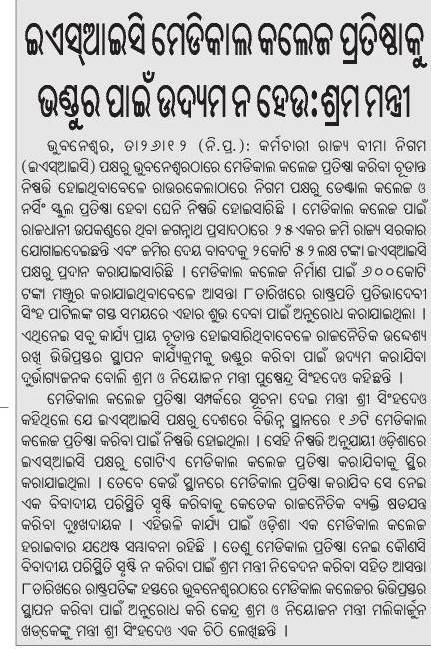I am delighted to be here today to participate in the foundation stone laying ceremony of this National Institute of Science Education and Research. The institute symbolizes our commitment to the development of Odisha and its people. It also symbolizes our commitment to the cause of education, and particularly to science education.
We recognise the important role that education has to play in our development process and our steady progress towards being a modern knowledge society. In the last about five years our government has undertaken a massive expansion and improvement of our education system at all levels. But we realize that we need to do much more.
In the area of science education particularly, I share the concern that our best minds are not turning to science. We must find ways of making science more attractive to our youth. We must improve the quality of teaching in science and mathematics at the school level. At the university level we must ensure better infrastructure, high quality faculty and greater interaction between academia and industry.
Since independence, there has been a great deal of progress in our Science & Technology system. This is evident from the success of the mission-oriented Science &Technology agencies, like the family of Department of Atomic Energy institutions, that have made our nation proud. We are committed to ensure operational autonomy, including in matters of appointments, to various institutions of excellence under the Department of Atomic Energy as is the case with some other scientific institutions of eminence in India.
I am also aware that we need to increase our expenditure on Science & Technology from its current level of 1% of our GDP. This is about half of the level of developed countries. The Government is committed to increasing Research & Development funding and for the last few years, we have been allocating larger budgets in this area. But I also expect the private sector to do more for Research & Development. We also need more public- private partnership in Research & Development in all areas of Science & Technology.
One way of making careers in science and technology attractive would be to improve remuneration and ensure the integrity of the selection process. It is well known that the initial starting salary for scientists with a PhD in India is often lower than those of Engineers, Doctors and Management graduates. It is obvious that if talented young people are to be retained in science, scientists have to be treated differently than other Government employees in service and salary matters.
It is our expectation that the National Institute of Science Education and Research will produce scientific trained manpower of a very high quality which could directly find placement across the country. There will be greater emphasis on branches of science relevant to the Department of Atomic Energy, which also cater to better exploitation and utilization of Odisha’s natural resources. Odisha’s mineral and marine resources will be taken into consideration in designing training programs for students here.
We expect NISER to be an institute at par with the best in the country in terms of facilities and faculty. It will have a research to teaching load as practiced in the best universities in the world. This will ensure world class education and also attract the best researchers. It will have world-class experimental facilities in all the current and emerging branches of science including physics, chemistry, modern biology and environmental sciences. I am confident that the National Institute of Science Education and Research will become an eminent institute for science like TIFR and IISc.
Let me end by wishing the National Institute of Science Education and Research all the very best in the years to come. Odisha has produced many outstanding scientists like Jogesh Chandra Pati. I hope this institution will produce many more great men of science. I also wish all of you all success in your efforts to make India stronger in Science and Technology.”
*****
AD
